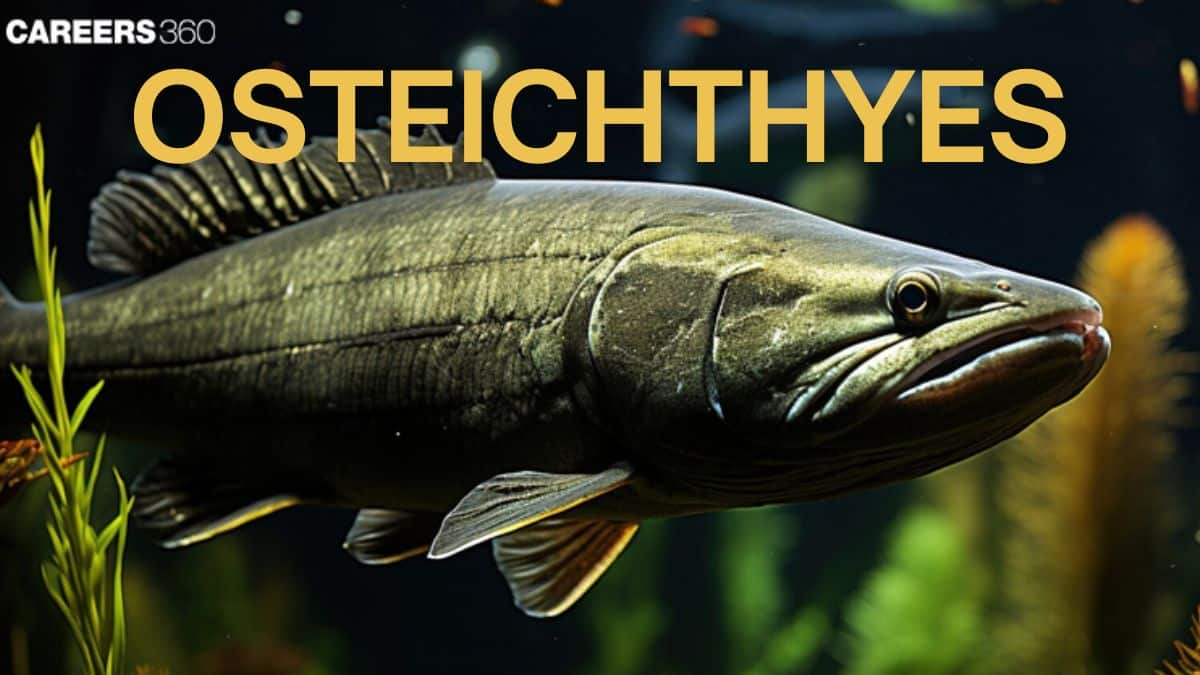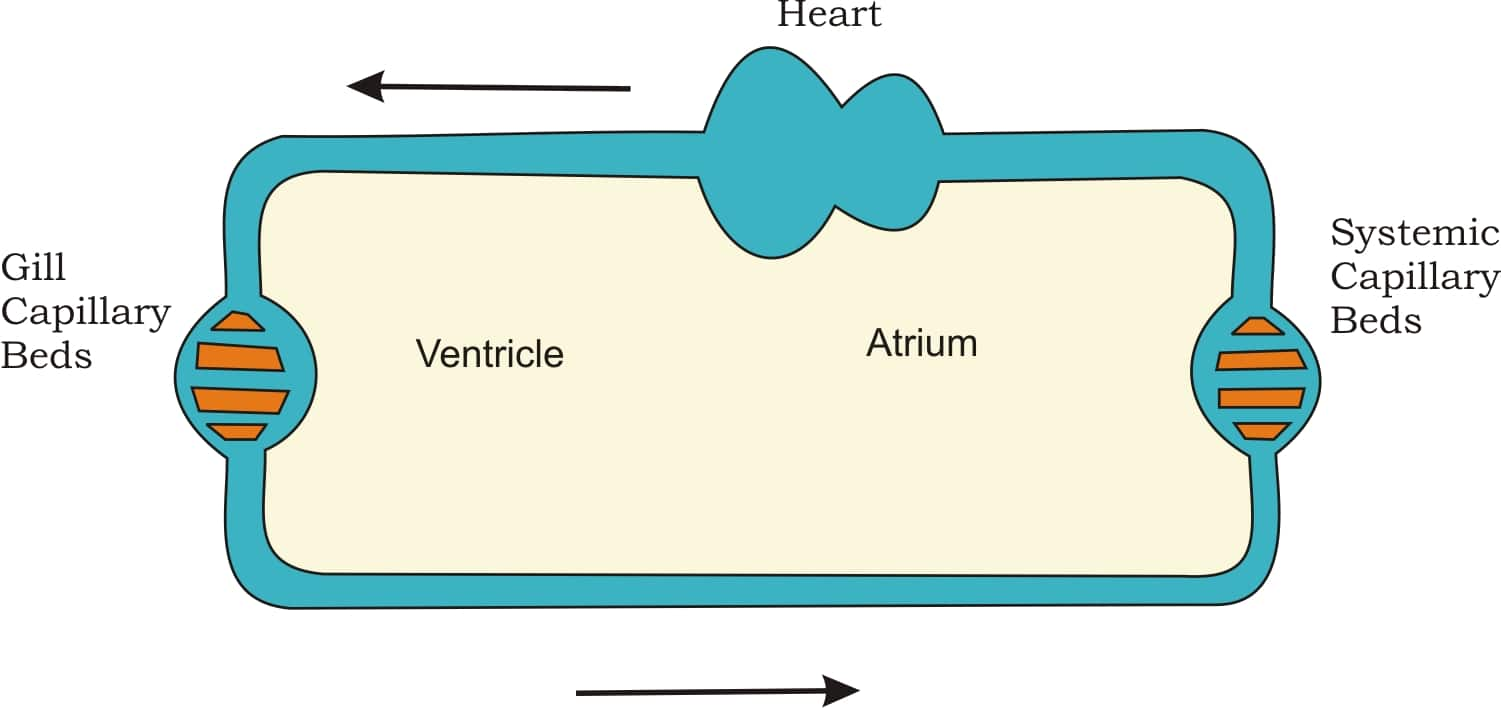Osteichthyes: Definition, Classification, Characteristics, Examples, Facts
The Osteichthyes commonly known as bony fishes is the largest and most diverse class of vertebrates on Earth involving over 30,000 species. These fish possess jaws, differentiating them from jawless fishes (Agnatha) and cartilaginous fishes (Chondrichthyes) in the Animal Kingdom. They have four pairs of gills, which are covered by an operculum on each side.
This Story also Contains
- Classification of Osteichthyes
- Characteristic Features of Osteichthyes
- Morphology and Anatomy of Osteichthyes
- Life Cycle of Osteichthyes
- Examples of Osteichthyes
- Conservation And Environmental Impact Osteichthyes
- Osteichthyes NEET MCQs
- FAQs on Osteichthyes
- Recommended Video for Osteichthyes

Osteichthyes live in marine and freshwater habitats. These bony fishes are an ecologically important class of vertebrates and have a vast distribution across the globe. Learn about Osteichthyes (bony fishes)—the largest and most diverse vertebrate class with over 30,000 species. Includes classification, features, morphology, anatomy, life cycle, examples, and conservation notes. NEET-ready notes, diagrams, and MCQs for Class 11–12 biology.
Classification of Osteichthyes
Osteichthyes is a class of fish within the division Gnathostomata, which includes all vertebrates possessing jaws. They are classified under vertebrata, having a notochord only in the embryonic stage, and later replaced by a vertebral column in adults.
Kingdom | |
Phylum | |
Subphylum | |
Division | Gnathostomata (jawed vertebrates) |
Superclass | Pisces |
Class | Osteichthyes (bony fishes) |
This class is further divided into two major subclass:
Actinopterygii
Actinopterygii are the largest subclass of Osteichthyes, containing modern bony fishes. Their fins are supported by long, thin, bony rays. They have gills covered by an operculum. Examples include Carassius auratus (goldfish), Catla, Rohu, and Hilsa
Sarcopterygii
Sarcopterygii are a small subclass with paired fins that are fleshy and lobed. These fins are considered ancestral to the limbs of amphibians. They have a bony skeleton, cosmoid scales, and internal nostrils. Examples include Latimeria (Coelacanth) and lungfishes like Neoceratodus (Australian lungfish).
Characteristic Features of Osteichthyes
Osteichthyes are characterized by a skeleton made primarily of bone, unlike cartilaginous fish, which have cartilage-based skeletons. All types of fish, as well as recent tetrapods, are of common ancestry and thus display the typical vertebrate body plan.
Characteristic Features | Description |
Bony Skeleton | The skeleton is composed of bone, providing structural support and rigidity. |
Paired Fins | They possess paired pectoral and pelvic fins, helping in balanced swimming |
Cycloid/Ctenoid Scales | Most have scales on their skin, giving protection and reducing water resistance. |
Gills covered by Operculum | The gills are located in gill chambers and are protected by a bony plate called the operculum. |
Swim Bladder | It is an internal gas-filled organ that helps in buoyancy control |
Morphology and Anatomy of Osteichthyes
The body shape of Osteichthyes ranges from streamlined forms in fast swimmers to flattened shapes in bottom dwellers.
Different types of scales, ctenoid and cycloid protect and reduce friction against the passage of water.
Their fins - all dorsal, pectoral, pelvic, ventral, and caudal - are each specialised to help the fish stay balanced, turn, and move forward.
It is powered through an endoskeleton, which consists mostly of bone, used for protection and structural support of internal organs.
This also features specialised muscles that enable efficient swimming, whether in red muscle used for sustained swimming or white muscle that provides the burst movements.
It has a mouth, oesophagus, stomach, and intestine in the digestive system for digestion.
The organism respires through the removal of oxygen from water using gills and gives out carbon dioxide, which is the byproduct formed during cellular respiration.
The circulatory system is a closed-loop system with a two-chambered heart (one auricle and one ventricle) that ensures proper functioning of body processes by delivering oxygenated blood throughout the body.
Life Cycle of Osteichthyes
The bony fishes have a simple life cycle. They grow from eggs (oviparous) into young fish and then into adults. Most lay eggs in water, and the baby fish look like small adults.
Actinopterygii often practice external fertilization, where eggs and sperm are released into water.
Sarcopterygii generally exhibit internal fertilization, with the transfer of sperm directly into the female's body.
Eggs are laid in water, with protective coatings to prevent desiccation.
Most species exhibit direct development, where the hatchlings resemble tiny adults, with no true metamorphosis.
Examples of Osteichthyes
Osteichthyes live in marine as well as freshwater habitats. Some of them live in aquariums. Examples of bony fishes in different habitats are:
Marine Species
Exocoetus (Flying Fish): It is known for its ability to glide above the water's surface.
Hippocampus (Seahorse): These are unique for their upright posture and unique reproductive behavior.
Freshwater Species
Labeo rohita (Rohu): A popular fish in South Asian aquaculture.
Catla catla: A large freshwater fish native to the Indian subcontinent.
Clarias batrachus (Magur): A species of catfish found in freshwater habitats.
Aquarium Species
Betta splendens (Fighting Fish): These are known for their vibrant colors and territorial behavior.
Pterophyllum scalare (Angelfish): They are recognized for their graceful swimming and distinctive body shape.
Conservation And Environmental Impact Osteichthyes
The Osteichthyes are under great threat from overfishing, habitat destruction, and pollution. All these factors contribute to the decline in fish populations and loss of biodiversity in aquatic ecosystems. Such pressures disrupt the ecological balance that impacts not only fish species but also the larger environments in which they live, both in the marine and freshwater environments.
To protect them, various conservation efforts have been made. For example, fishing quotas, marine reserves, and other sustainable ways of catching fish. In the same way, habitat restorations render damaged ecosystems safe again. These actions aim to conserve fish populations and protect their habitats for the future.
Osteichthyes NEET MCQs
Q1. Which is not the feature of Osteicthyes ?
Swim bladder present
Gill slits show presence of Operculum
Placoid scales are present
Endoskeleton is made up of Bone
Correct answer: 3) Placoid scales are present
Explanation:
Osteichthyes are a class of fish characterized by having an endoskeleton made of bone rather than cartilage, as seen in cartilaginous fish (Chondrichthyes). Osteichthyes include a wide variety of species, with two major groups: ray-finned fish (Actinopterygii) and lobe-finned fish (Sarcopterygii). Examples of Osteichthyes include species like the hippocampus (seahorse) and the betta (betta fish). These fish possess a bony skeleton, and a swim bladder for buoyancy, and are found in diverse aquatic environments around the world.
Hence the correct answer is option 3) Placoid scales are present.
Q2. Osteichthyes are cold blooded , that is they are
Homiotherms
Poikilotherms
Heat escape from body and then remain cold
They live in water
Correct answer: 3) Poikilotherms
Explanation:
Osteichthyes, usually called bony fish, are cold-blooded or poikilothermic animals. Their body temperature, therefore, depends on environmental conditions rather than physiological processes. Metabolic rates and activity levels vary according to water temperatures in such organisms. This makes them perfect for all kinds of aquatic habitats, but they are also sensitive to temperature changes, which affect their survival and distribution in several ecosystems.
Hence the correct answer is Option 2) Poikilotherms.
Q3. Which of the following animals has a two-chambered heart?
Labeo rohita
Salamander
Chelone
All of these
Correct answer: 1) Labeo rohita
Explanation:
Salamander and Chelone (commonly called Lizard) belong to the group Amphibia and Reptiles, which shows 3 chambered hearts (two auricles and one ventricle).
Labeo rohita is a true fish and fishes have a two-chambered heart.

Hence, the correct answer is option 1) Labeo rohita.
Also Read:
FAQs on Osteichthyes
What are Osteichthyes?
Osteichthyes, also known as bony fishes, are fishes whose skeleton is made mainly of bone rather than cartilage. They are the largest group of fishes and are found in a wide range of aquatic habitats, including freshwater lakes, rivers, and marine environments. Examples include Labeo (Rohu), Catla, Clarias (Catfish), Hippocampus (Seahorse), and Latimeria.
How are Osteichthyes classified?
Osteichthyes are classified into two main subclasses:
Actinopterygii (ray-finned fishes) – These have fins supported by long, thin bony rays. They make up the majority of modern fishes, such as Rohu and Catla.
Sarcopterygii (lobe-finned fishes) – These have fleshy, lobed fins with a bony skeleton inside, considered more primitive and closely related to amphibians. Example: Latimeria
What are the features of Osteichthyes?
They have a bony endoskeleton, a streamlined body, and gills covered by an operculum. The skin is covered with cycloid, ctenoid, or ganoid scales. They possess a swim bladder for buoyancy, are cold-blooded (poikilothermic), and usually exhibit external fertilisation with oviparous reproduction.
Explain the life cycle of Osteichthyes
The life cycle of Osteichthyes begins with external fertilisation, where eggs and sperm are released into the water. Fertilised eggs develop into embryos, which hatch into larvae. The larval stage is free-swimming and undergoes several developmental changes. As the larvae grow, they transform into juveniles, resembling adults. Juveniles continue to grow and reach sexual maturity, becoming fully developed adults capable of reproduction. This cycle then repeats with each breeding season.
Recommended Video for Osteichthyes
Frequently Asked Questions (FAQs)
These bony fishes belong to the phylum Chordata and subphylum Vertebrata.
Osteichthyes live in a wide variety of aquatic habitats, including marine and freshwater environments.
These swimming adaptations could include things such as streamlined body shapes for effective locomotion, specialized muscles for various swimming speeds, and fins for stabilization, manoeuvrability, and propulsion.
Bony fish maintain buoyancy with the help of their swim bladder, an internal organ filled with gas bubble pairs. This allows the fish to stabilize at the chosen depth in the water without expenditure of any energy.
Bony fish are a major source of protein for humans and are essential to global fisheries and aquaculture industries, contributing significantly to food security and economies.
Bony fish will normally reproduce by external fertilization, where eggs and sperm are released into the water, but some species do show internal fertilization.